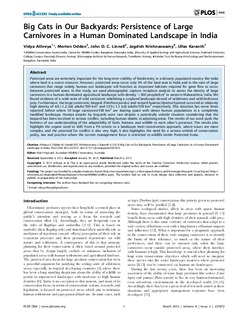Big Cats in Our Backyards: Persistence of Large Carnivores in a Human Dominated Landscape in India
Journal article, Peer reviewed
Permanent lenke
http://hdl.handle.net/11250/134576Utgivelsesdato
2013Metadata
Vis full innførselSamlinger
Originalversjon
Athreya, V., Odden, M., Linnell, J. D., Krishnaswamy, J., & Karanth, U. (2013). Big Cats in Our Backyards: Persistence of Large Carnivores in a Human Dominated Landscape in India. PLoS ONE, 8(3). doi: 10.1371/journal.pone.0057872Sammendrag
Protected areas are extremely important for the long term viability of biodiversity in a densely populated country like India
where land is a scarce resource. However, protected areas cover only 5% of the land area in India and in the case of large
carnivores that range widely, human use landscapes will function as important habitats required for gene flow to occur
between protected areas. In this study, we used photographic capture recapture analysis to assess the density of large
carnivores in a human-dominated agricultural landscape with density .300 people/km2 in western Maharashtra, India. We
found evidence of a wide suite of wild carnivores inhabiting a cropland landscape devoid of wilderness and wild herbivore
prey. Furthermore, the large carnivores; leopard (Panthera pardus) and striped hyaena (Hyaena hyaena) occurred at relatively
high density of 4.861.2 (sd) adults/100 km2 and 5.0361.3 (sd) adults/100 km2 respectively. This situation has never been
reported before where 10 large carnivores/100 km2 are sharing space with dense human populations in a completely
modified landscape. Human attacks by leopards were rare despite a potentially volatile situation considering that the
leopard has been involved in serious conflict, including human deaths in adjoining areas. The results of our work push the
frontiers of our understanding of the adaptability of both, humans and wildlife to each other’s presence. The results also
highlight the urgent need to shift from a PA centric to a landscape level conservation approach, where issues are more complex, and the potential for conflict is also very high. It also highlights the need for a serious rethink of conservation
policy, law and practice where the current management focus is restricted to wildlife inside Protected Areas
